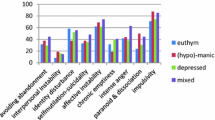Abstract.
Background:
Angst has recently found an association between the bipolar spectrum and a personality trait called “ups & downs”, defined by the question “would you say you were one of those people who have frequent ups and downs?”. Study aimwas to find the frequency of “ups & downs” in a large sample of bipolar II (BPII) and major depressive disorder (MDD),and to test its association with BPII.
Methods:
Consecutive 89 MDD and 89 BPII outpatients were interviewed, during a major depressive episode (MDE),with the Structured Clinical Interview for DSM-IV, as modified by Benazzi and Akiskal (2003). Hypomanic symptoms during MDE were systematically assessed. The association between “ups & downs” (defined by Angst’s question) and BPII was tested versus bipolar validators (young onset, many recurrences, atypical depression, depressive mixed state [MDE plus 3 or more concurrent hypomanic symptoms, following Akiskal and Benazzi’s definition (2003)], and bipolar family history. Associations were tested by univariate and multivariate logistic regression (STATA 7).
Results:
“ups & downs” was present in 62.9% of BPII and in 33.7% of MDD (ratio = 1.86, p = 0.0001). All bipolar validators were significantly more common in BPII versus MDD. Sensitivity and specificity of bipolar validators for predicting BPII, including “ups & downs”, showed that “ups & downs” had a balanced combination of sensitivity (62.9 %) and specificity (66.2 %) (i. e., sensitivity not too low compared to specificity and vice versa) for predicting BPII, and that it was strongly associated with BPII (odds ratio = 3.3, 95% CI 1.8–6.1). Multivariate analyses found that “ups & downs” independently and significantly predicted BPII among the other bipolar validators. Patients did not confuse “ups & downs” with many past MDEs, as the association with BPII did not change when controlled for recurrences.
Conclusions:
Findings suggest that Angst’s “ups and downs” might be a new marker of BPII. Its simple question might be useful to clinicians to better detect the highly underdiagnosed BPII during assessment of depression.
Similar content being viewed by others
Author information
Authors and Affiliations
Corresponding author
Rights and permissions
About this article
Cite this article
Benazzi, F. Validating Angst’s “ups & downs” personality trait as a new marker of bipolar II disorder. European Archives of Psychiatry and Clinical Neurosciences 254, 48–54 (2004). https://doi.org/10.1007/s00406-004-0455-8
Received:
Accepted:
Issue Date:
DOI: https://doi.org/10.1007/s00406-004-0455-8




